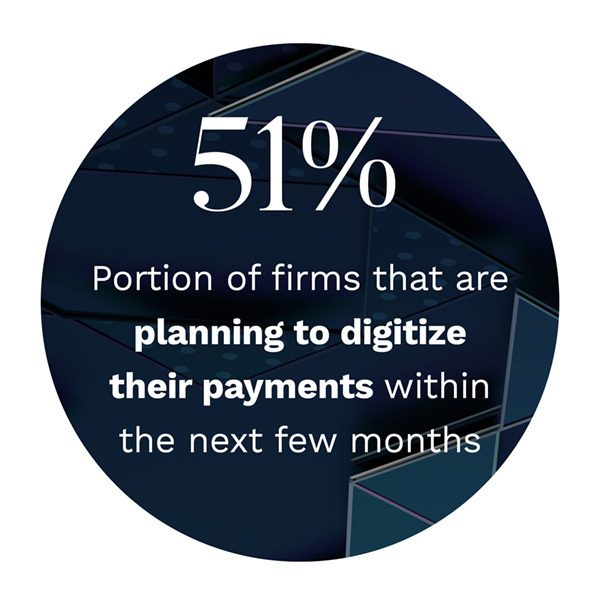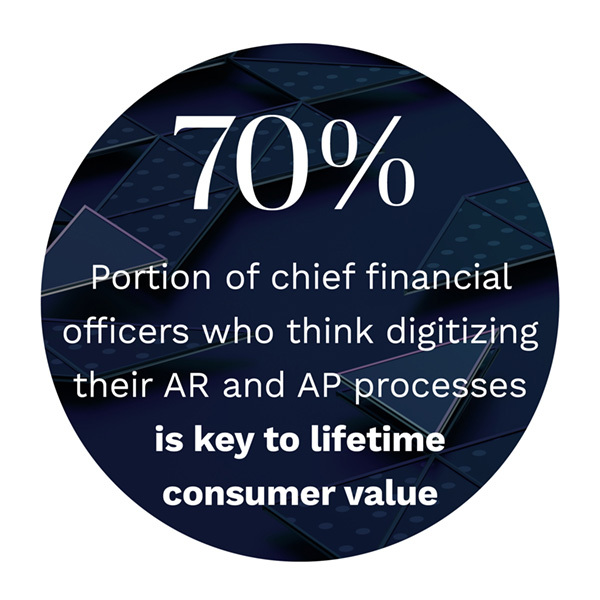Turning Receivables Into Integrated Payments Solutions Boosts Supplier Relationships

Reducing costs and improving efficiencies have always been top priorities for businesses across industries. Doing so has only become more critical given the lingering economic effects of the global health crisis. Many companies are still racing to innovate how they communicate internally as employees remain remote and how they handle previously routine business-to-business (B2B) payments or other transactions that used to be finalized manually.
Migrating away from manual payment tools is also becoming more important for firms as their clients’ frustrations over late payments increase. One recent PYMNTS study found that 70 percent of chief financial officers agreed that digitizing their accounts payable (AP) and accounts receivable (AR) processes will be key to retaining customer value and loyalty. Firms must therefore analyze what technologies and solutions can help them move forward with their B2B payment digitization plans without adding additional frictions. Incorporating enterprise resource planning (ERP) systems alongside emerging payment methods is one way businesses may be able to introduce swifter, more seamless payments for their clients while also enabling them to manage their AR and AR processes with more transparency.
In the latest Next-Gen Digital Payments Report, PYMNTS analyzes how businesses pair ERP systems with emerging payment methods to develop faster, more seamless AR and AP processes. It will also examine what role artificial intelligence (AI) and machine learning (ML) can play in this space and how companies can look to keep pace with the payment needs of their clients as they continue to shift.
Around The Digital Payments Space
Businesses are increasingly searching for solutions that can allow them to ease payment
p ain points, leading to a rising interest in embedded finance tools among companies. These solutions allow payments to be made directly via websites or mobile apps, eliminating extra steps to speed up transactions. Forty-seven percent of businesses in the United States noted they have already begun investing in embedded finance solutions as the need to streamline their AR and AP processes sharpens. Eighty-eight percent of organizations that are already using embedded finance tools claimed such solutions were highly successful for improving customer engagement, for that matter. Businesses should therefore look to examine how implementing these or related solutions could help to ease payment frictions at their organizations.
ain points, leading to a rising interest in embedded finance tools among companies. These solutions allow payments to be made directly via websites or mobile apps, eliminating extra steps to speed up transactions. Forty-seven percent of businesses in the United States noted they have already begun investing in embedded finance solutions as the need to streamline their AR and AP processes sharpens. Eighty-eight percent of organizations that are already using embedded finance tools claimed such solutions were highly successful for improving customer engagement, for that matter. Businesses should therefore look to examine how implementing these or related solutions could help to ease payment frictions at their organizations.
Companies are also taking closer looks at the underlying infrastructure they use to support their AP and AR processes as they move to implement embedded finance or other emerging technologies. Eighty-seven percent of businesses recently reported they are planning to begin modernization programs for their mainframe-based legacy systems within the next few years, for example. The highest driver for doing so appears to be reducing costs, as well as the flexibility that moving to upgraded systems can grant them. Six out of 10 businesses surveyed noted that modernizing just one of their legacy systems could reduce their overall IT costs by about one-third, indicating that moving away from mainframes may be advantageous.
Technologies such as application programm ing interfaces (APIs) and ERPs may play a key role within companies’ AR and AP processes in the future as they look to move on from legacy technologies. Seventy-three percent of corporate treasury professionals already stated APIs are a critical part of their companies’ operations, for example. APIs and related platforms make it easier to view money movement at businesses with more transparency, allowing treasurers to better manage their cash flow, set budgets or conduct other financial tasks. Treasurers also indicated that supporting such transparency is becoming increasingly important, with 88 percent noting cash forecasting is critical while only 34 percent agreed they were conducting such forecasting with a high degree of accuracy. Closing this gap is likely to be a key focus for treasurers moving forward and may accelerate the use of APIs and ERPs within businesses.
ing interfaces (APIs) and ERPs may play a key role within companies’ AR and AP processes in the future as they look to move on from legacy technologies. Seventy-three percent of corporate treasury professionals already stated APIs are a critical part of their companies’ operations, for example. APIs and related platforms make it easier to view money movement at businesses with more transparency, allowing treasurers to better manage their cash flow, set budgets or conduct other financial tasks. Treasurers also indicated that supporting such transparency is becoming increasingly important, with 88 percent noting cash forecasting is critical while only 34 percent agreed they were conducting such forecasting with a high degree of accuracy. Closing this gap is likely to be a key focus for treasurers moving forward and may accelerate the use of APIs and ERPs within businesses.
For more on these and other stories, visit the Report’s News & Trends.
How ERP Systems, RTP Can Help Aid Businesses As They Move To Adopt Instant Payments
Eliminating payment frictions has always been a top priority for firms, but a s many companies are still working with B2B infrastructure and payment tools built around paper checks, doing so at speed can be difficult. Removing AR and AP pain points can be especially tricky as the number of payment types organizations must support expands, for that matter. This makes it key for businesses to have systems that can support the payment diversity becoming more critical to their success while also creating space for them to adopt speedier payment solutions, explained Carl Slabicki, head of strategic payment solutions at BNY Mellon. To learn more about why ERP systems and networks such as The Clearing House’s Real-Time Payment (RTP) Network can grant businesses the speed and seamlessness they are looking for in their AR and AP processes, visit the Report’s Feature Story.
s many companies are still working with B2B infrastructure and payment tools built around paper checks, doing so at speed can be difficult. Removing AR and AP pain points can be especially tricky as the number of payment types organizations must support expands, for that matter. This makes it key for businesses to have systems that can support the payment diversity becoming more critical to their success while also creating space for them to adopt speedier payment solutions, explained Carl Slabicki, head of strategic payment solutions at BNY Mellon. To learn more about why ERP systems and networks such as The Clearing House’s Real-Time Payment (RTP) Network can grant businesses the speed and seamlessness they are looking for in their AR and AP processes, visit the Report’s Feature Story.
Deep Dive: Why Pairing ERP With A2A, Emerging Payments Is Essential To AR, AP Innovation
The need for digitization is only growing more apparent for companies as the cost of remaining reliant upon manual tools or paper checks for their B2B payment needs grows. Fifty-one percent of CFOs admitted they had missed project deadlines due to their organizations’ continued use of outdated AR and AP tools, for one example. Supporting payment methods such as instant account-to-account (A2A) transfers or other digital-first methods could allow companies to solve such pain points. Still, they must first consider how such payments can be paired with their ERP systems for best effects. To learn more about why integrating emerging payment methods into their AP and AR processes could provide key benefits for businesses, visit the Report’s Deep Dive.
About The Report
The Next-Gen Digital Payments Report, a PYMNTS and Transcard collaboration, explores how businesses and consumers are turning to embedded payment options, including buy buttons, to access seamless digital purchasing experiences as they transact around the globe.
